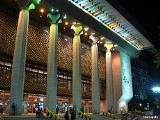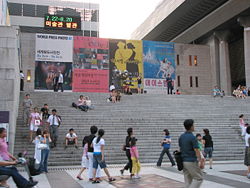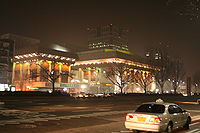
Sejong Center
Encyclopedia
Sejong Center for the Performing Arts (or Sejong Center) is the largest arts and cultural complex in Seoul
, South Korea
. It has an interior area of 53,202m². It is situated in the center of the capital, on Sejongno
, a main road that cuts through the capital city of the Joseon Dynasty
. The center took 4 years to complete, opening its doors in 1978. It was "built as a cultural center for Seoulites." It currently is home to the biggest pipe organ
in Asia
.
The center's design was based on a fusion of Korean national symbols and the western architectural designs. The name "Sejong" is from the 4th ruling King of the Joseon Dynasty
, Sejong the Great
.

 The Sejong Center is made up of many different halls, centers and theaters.
The Sejong Center is made up of many different halls, centers and theaters.
Seoul
Seoul , officially the Seoul Special City, is the capital and largest metropolis of South Korea. A megacity with a population of over 10 million, it is the largest city proper in the OECD developed world...
, South Korea
South Korea
The Republic of Korea , , is a sovereign state in East Asia, located on the southern portion of the Korean Peninsula. It is neighbored by the People's Republic of China to the west, Japan to the east, North Korea to the north, and the East China Sea and Republic of China to the south...
. It has an interior area of 53,202m². It is situated in the center of the capital, on Sejongno
Sejongno
Sejongno is a street that cuts through Jongno-gu in downtown Seoul. It is named after King Sejong. The street is only 600 meters in length, but thanks to its central location it is of great symbolic importance. It points north to Gwanaksan and Bukhansan , and the Joseon Dynasty palace,...
, a main road that cuts through the capital city of the Joseon Dynasty
Joseon Dynasty
Joseon , was a Korean state founded by Taejo Yi Seong-gye that lasted for approximately five centuries. It was founded in the aftermath of the overthrow of the Goryeo at what is today the city of Kaesong. Early on, Korea was retitled and the capital was relocated to modern-day Seoul...
. The center took 4 years to complete, opening its doors in 1978. It was "built as a cultural center for Seoulites." It currently is home to the biggest pipe organ
Pipe organ
The pipe organ is a musical instrument that produces sound by driving pressurized air through pipes selected via a keyboard. Because each organ pipe produces a single pitch, the pipes are provided in sets called ranks, each of which has a common timbre and volume throughout the keyboard compass...
in Asia
Asia
Asia is the world's largest and most populous continent, located primarily in the eastern and northern hemispheres. It covers 8.7% of the Earth's total surface area and with approximately 3.879 billion people, it hosts 60% of the world's current human population...
.
History
After the Seoul National Hall was destroyed by fire in 1972, the City Council of Seoul commissioned the construction of a venue to continue the cultural heritage of that structure. Built in 1978, commissioned by the City of Seoul, Sejong Center was largely unsupported financially for 20 years, being under the control of the Special City of Seoul. In 1999, the center was placed under control of a foundation governed by civilians whose passion for the arts fueled its massive newfound success.The center's design was based on a fusion of Korean national symbols and the western architectural designs. The name "Sejong" is from the 4th ruling King of the Joseon Dynasty
Joseon Dynasty
Joseon , was a Korean state founded by Taejo Yi Seong-gye that lasted for approximately five centuries. It was founded in the aftermath of the overthrow of the Goryeo at what is today the city of Kaesong. Early on, Korea was retitled and the capital was relocated to modern-day Seoul...
, Sejong the Great
Sejong the Great of Joseon
Sejong the Great was the fourth king of the Joseon Dynasty of Korea. During his regency, he reinforced Korean Confucian policies and executed major legal amendments . He also used the creation of Hangul and the advancement of technology to expand his territory...
.
Forming Facilities


The Main Auditorium
The "Big" Theater as it is called in Korean, is a technologically advanced theater.The Minor Hall
Called The "Small" Theater in Korean, is constructed in an interesting style over 2 floors, and can seat 442 people, the stage can allow for 100 people on performance.Arts Forum Galleries
- Main Gallery: The Arts Forum is a large room (1,056 m²) that is divided into 4 separate rooms for viewings of different sizes and numbers.
- New Gallery: The New Gallery is a (594 m²) place for artwork that excels in the social, popular and cultural side of Korean art.
- Gwang Hwa Moon Gallery: Originally part of the 5th Line Subway Metro System, it houses artworks that are considered to be outstanding by the youth and new up-and-coming artists. Considered to be an example of Subway Art Galleries.
Gwang Hwa Rang
The Gwang Hwa Rang is situated underneath the Sejong-ro crossroads, it opened on February 17, 2005 with complete free access to pedestrians and art-discerning Seoulites. It includes a window-gallery that enable by-passers on ground level to peek inside.Sejong Convention Center and Hall
The Convention Center and Hall is usually used for big events and conferences. With a size of 627 m², it can house around 400 people. It is available for many different events. It includes 250 translating systems that interprets five different languages simultaneously. The convention hall has a smaller size convention center that is used for similar purposes and is able to accommodate 120 people.Sam Chung Gak
Measuring in 19417m², Sam Chung Gak is a collaboration of six traditional Korean Housings. Since 2001, it has been used by the Center as a place for traditional heritage experience.Resident Companies
- Seoul Philharmonic
- Seoul National Philharmonic
- Seoul Metropolitan Theater Company
- City of Seoul Musical Company
- Seoul Metropolitan Chorus
- Seoul National Traditional Dance Company
- Seoul Metropolitan Opera
- Seoul Youth Orchestra
- Seoul Youth Choir
See also
- Contemporary culture of South KoreaContemporary culture of South KoreaThe contemporary culture of South Korea developed from the traditional culture of Korea, and on its own path away from North Korean culture since the division of Korea in 1948. The industrialization and urbanization of South Korea, especially Seoul, have brought many changes to the way Korean...
- Korean performing arts
- List of concert halls
- List of Korea-related topics
- Sejong the Great of JoseonSejong the Great of JoseonSejong the Great was the fourth king of the Joseon Dynasty of Korea. During his regency, he reinforced Korean Confucian policies and executed major legal amendments . He also used the creation of Hangul and the advancement of technology to expand his territory...

